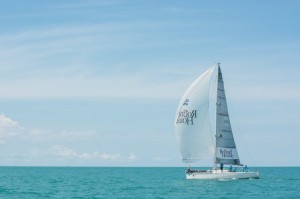Two Navy Guys Talk About Spy Ships
 Welcome back to Two Navy Guys and a Novel, the blog series where two ex-Navy guys talk about the process and the pitfalls of co-writing a military thriller. If you’re new to the team and want to catch up on previous episodes, visit our web page.
Welcome back to Two Navy Guys and a Novel, the blog series where two ex-Navy guys talk about the process and the pitfalls of co-writing a military thriller. If you’re new to the team and want to catch up on previous episodes, visit our web page.
Pop quiz: Without using Google or the Interweb, what is an AGI?
Your first guess might be another big Wall Street institution bailed out by the government, but you're thinking of AIG.
If you’ve ever been to sea on a US Navy ship, you know the answer: a Soviet spy ship. Technically speaking AGI stands for Auxiliary General Intelligence, but more often these little buggers were derisively known as “fishing vessels” (air quotes mandatory) to naval officers. AGIs tend to hang out in international waters outside of major naval ports and show up when there are naval exercises going on.
A (Short) History Lesson
 When the Cold War began, the world turned bipolar. Besides the much-publicized arms race between NATO and the Warsaw Pact, both groups also developed new and better ways to facilitate technical intelligence collection. SIGINT, or signals intelligence, can be either communications intelligence (think codes and voice calls) or electronic intelligence, such as new types of radar.
When the Cold War began, the world turned bipolar. Besides the much-publicized arms race between NATO and the Warsaw Pact, both groups also developed new and better ways to facilitate technical intelligence collection. SIGINT, or signals intelligence, can be either communications intelligence (think codes and voice calls) or electronic intelligence, such as new types of radar.
And lest you think it was only the Evil Soviets doing this kind of stuff, the United States was converting World War II-era LIBERTY ships for intelligence collection. You may have heard of the USS PUEBLO? That was a spy ship.
Disguise or plain sight?
Today, little secrecy is employed for intelligence collection from ship-based platforms. Most nations understand that building, launching, and operating a clandestine “spy” ship is extraordinarily difficult and expensive. Instead, nations tend to build intelligence collection ships that are very clearly intelligence collection ships.
Today, for example, the Russian Navy uses three different classes of AGIs. Those classes include: the VISHNYA, the BALZAM, and the PRIMOR’YE. The VISHNYA-class vessels provide the bulk of AGI support to the Russian intelligence “apparatus” as the other vessels are older and most have been decommissioned.
Not to be outdone, the US has a few vessels of our own for intelligence gathering, although we call them “technical research ships.” The USNS OBSERVATION ISLAND, see left, is designed to collect a wide array of technical signals, including telemetry, as part of its mission as a Missile Range Instrumentation Ship.
Still, when you check either of these ships out, the word “clandestine” does not exactly spring to mind.
Purpose-built naval ships are not the only ways in which nations have employed vessels to collect intelligence. The old Soviet fishing fleet often trawled outside US naval bases all over the world and had a remarkable variety of instrumentation affixed to their hulls. As any naval line officer will tell you, when you see a “fishing vessel” sporting so many antennae it looks like a porcupine, you’re not fooled by the nets hanging off the back.
The Coolest Deep Cover Spy Ship You Could Ever Imagine
So what happens when a known spy ship cruises along a foreign coastline or makes a pass at a naval exercise? You guessed it: they shut the exercise down or change it to limit the amount of useful intel that is being sent into the ether.
In Weapons of Mass Deception, we envision a different kind of spy ship. Picture a party boat driven by a hotshot Silicon Valley millionaire who’s cashed in all his stock and is using his money to sail the world with a few friends in a big-ass sailboat, a sailboat packed to the gunwales with all the latest in super-secret receivers and manned by a handful of brainiacs.
What if that was the US Navy’s newest SIGINT-gathering platform?
David Bruns is the creator of the sci-fi series The Dream Guild Chronicles, and one half of the Two Navy Guys and a Novel blog series about co-writing the military thriller, Weapons of Mass Deception. Check out his website for a free sample of his work.




